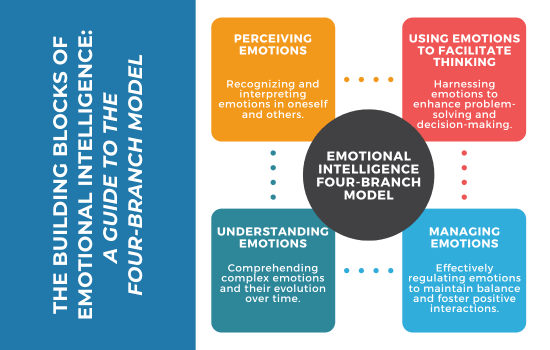Emotional intelligence shapes our ability to navigate life’s challenges with self-awareness and resilience. The Four-Branch Model offers a framework to understand emotion, enhance decision-making, and strengthen interpersonal relationships for personal and professional success.
Mastering Emotional Intelligence: Understanding The Four-Branch Model

Have you ever reacted emotionally in a situation and later wished you had handled it differently? Imagine having the ability to stay calm under pressure, connect deeply with others, and make smarter decisions, this is the power of the Four-Branch Model of Emotional Intelligence. Developed by psychologists Peter Salovey and John D. Mayer, this model breaks emotional intelligence into four key areas: self-awareness, using emotions to facilitate thinking, understanding emotions, and managing emotions. Mastering these skills can help you navigate life's challenges with confidence and purpose.
Why Emotional Intelligence Matters
Emotional intelligence is a cornerstone for personal and professional success. Unlike IQ, which measures cognitive abilities, emotional intelligence focuses on our capacity to recognize, understand, and manage emotions in ourselves and others. Cultivating emotional intelligence (EI) allows us to build stronger relationships, make wiser decisions, and handle adversity with resilience and empathy.
At the heart of this concept lies the Four-Branch Model of Emotional Intelligence, which provides a practical roadmap for understanding and applying EI:
-
Perceiving Emotions: Recognizing and interpreting emotions in oneself and others.
-
Using Emotions to Facilitate Thinking: Harnessing emotions to enhance problem-solving and decision-making.
-
Understanding Emotions: Comprehending complex emotions and their evolution over time.
-
Managing Emotions: Effectively regulating emotions to maintain balance and foster positive interactions.
Real-World Applications of the Four-Branch Model
-
Personal Development and Well-Being
-
Improved Self-Awareness: Recognizing and perceiving emotions (Branch 1) helps us understand how feelings influence thoughts and behaviours.
-
Emotional Resilience: Managing emotions (Branch 4) reduces stress, fosters well-being, and enhances mental health.
-
Better Decision-Making: Using emotions to guide thinking (Branch 2) leads to improved judgment and personal growth.
-
Example: Picture a time when frustration clouded your decision-making. By applying emotional intelligence, you could recognize the frustration, use it constructively, and make a clearer choice.
-
-
Workplace Effectiveness
-
Leadership Development: Great leaders inspire teams by understanding (Branch 3) and managing (Branch 4) emotions effectively.
-
Stronger Team Collaboration: Recognizing emotions (Branch 1) and regulating them (Branch 4) leads to better communication and workplace harmony.
-
Conflict Resolution: Understanding emotional perspectives (Branch 3) helps mediate disputes and create win-win solutions.
-
Example: A manager notices tension in a team meeting. By recognizing team members’ frustrations and addressing concerns with empathy, they diffuse conflict and strengthen collaboration.
-
-
Education
-
Emotional Literacy: Teaching students to recognize and articulate emotions (Branch 1) fosters empathy and emotional intelligence.
-
Motivation and Engagement: Using emotions to enhance reasoning (Branch 2) boosts students' intrinsic motivation.
-
Classroom Management: Educators who manage their emotions (Branch 4) create a more supportive learning environment.
-
Example: A teacher practicing emotional intelligence remains calm when a student acts out, responding with patience instead of frustration.
-
-
Therapy and Counseling
-
Building Rapport: Perceiving emotions (Branch 1) helps therapists connect with clients more deeply.
-
Developing Coping Strategies: Understanding (Branch 3) and managing (Branch 4) emotions fosters resilience.
-
Facilitating Change: Using emotions strategically (Branch 2) supports goal-setting and personal growth.
-
Example: A counsellor helps a client recognize patterns in emotional triggers, leading to meaningful behavioural changes.
-
-
Parenting and Relationships
-
Strengthening Emotional Bonds: Recognizing and validating emotions (Branch 1) deepens connections with loved ones.
-
Effective Conflict Management: Understanding (Branch 3) and regulating (Branch 4) emotions promotes harmony.
-
Role Modeling: Demonstrating emotional regulation (Branch 4) teaches children how to manage their feelings.
-
Example: A parent validates a child’s disappointment instead of dismissing it, fostering emotional intelligence in the child.
-
-
Social Justice and Advocacy
-
Empathy and Perspective-Taking: Understanding diverse emotional experiences (Branch 3) bridges divides.
-
Effective Communication: Using emotions persuasively (Branch 2) strengthens advocacy efforts.
-
Example: A public speaker uses emotional intelligence to connect with an audience and inspire action.
-
Unlock Your Emotional Intelligence Potential
The Four-Branch Model of Emotional Intelligence offers a comprehensive and actionable guide to mastering emotions for personal growth, stronger relationships, and professional success. By honing the skills to perceive, use, understand, and manage emotions, you can navigate life’s complexities with empathy, resilience, and purpose.
Investing in EI training isn’t just a trend, it’s essential for thriving in today’s world. Are you ready to elevate your EI? Our EQ-i 2.0 Self-Assessment provides personalized insights to help you unlock your full potential. Let The Power of Emotion book be your practical guide to a more emotionally intelligent future. Contact us today to begin your journey to a more emotionally intelligent life!
More Motivational Reads Here »
How Emotionally Intelligent Are You?
Sign up for Linda’s monthly tips to build your Emotional Intelligence and reduce Emotional Hijacking!

















